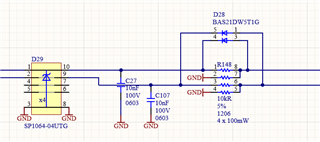Other Parts Discussed in Thread: TIC12400, , TIC12400-Q1
Dear forum,
we're planning to use the TIC10024-Q1, TIC12400, TIC12400-Q1 in a 48V system, with Vbat,max=56V.
The IC is supplied from a regulated 12V.
All inputs are switches towards GND.
We have two requirements for the device input:
- Input is safe for an extended shortcut to battery voltage of 56V, also when regulated 12V is off
- able to detect an external shortcut to high or to a neighboring input through a manipulation of wetting currents and input probing.
Would below network be sufficient to achieve this? Left side is external connector side, right side goes towards TIC12400 pins, two channels are shown.
Idea behind this is: The resistor divider network scales the max 56V down to 28V to stay in the safe 40V range of the TIC12400.
The diode provides a low-impedance path for the wetting current for a closed switch.
This network would still allow us to detect an external harness shortcut to 12V or Vbat by setting the wetting current to 0mA and probing the input then. A neighboring shortcut we would detect by setting the neighboring input's wetting current to a high value and probing then.

Happy to hear any additional ideas (or devices) that could help achieve that behavior.
Best regards,
Lorenz

